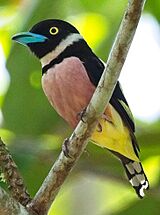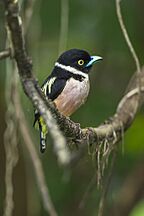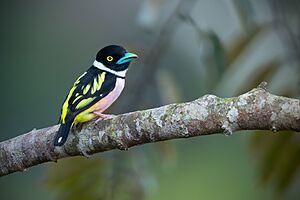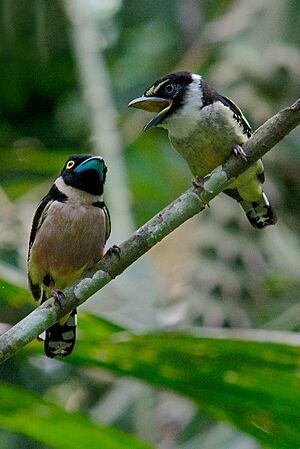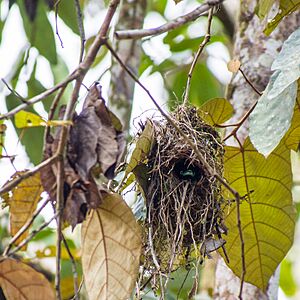Black-and-yellow broadbill facts for kids
Quick facts for kids Black-and-yellow broadbill |
|
|---|---|
|
|
|
| Male, female | |
| Conservation status | |
| Scientific classification | |
| Genus: |
Eurylaimus
|
| Species: |
ochromalus
|
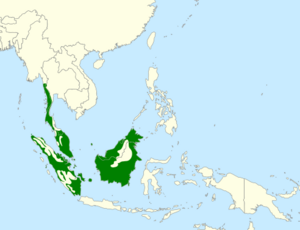 |
|
| Black-and-yellow broadbill distribution | |
| Synonyms | |
The black-and-yellow broadbill (Eurylaimus ochromalus) is a unique bird. It belongs to the typical broadbill family, called Eurylaimidae. This small bird is easy to spot. It has a black head and a black band across its chest. Its upper body is also black. A white band circles its neck. You can see bright yellow streaks on its back and wings. Its belly is a pretty pink color, which turns yellow closer to its tail.
The black-and-yellow broadbill has a bright blue beak. The top part of its beak has a green tip. The edges of its beak are black. Male and female broadbills look a little different. Females have a gap in the middle of their black chest band.
This bird lives in several countries. These include Brunei, Indonesia, Malaysia, Myanmar, Singapore, and Thailand. It prefers forests like evergreen forests and swamp forests. It also lives in secondary forests and tree plantations. These areas must have large trees for the bird to live there. Black-and-yellow broadbills mostly live in lowlands. They can be found up to 1,220 meters (4,000 feet) high. They mainly eat insects. They also eat snails and sometimes fruit.
Black-and-yellow broadbills build their nests during the dry season. Both parents help build a large, pear-shaped nest. It is made of moss, fungus, and leaves. They usually lay two or three eggs. Sometimes, a fourth smaller egg is laid. Both parents take turns keeping the eggs warm. The IUCN lists this bird as near-threatened. This means its numbers are going down. This is mainly because its forest home is disappearing.
Contents
About the Black-and-Yellow Broadbill
What's in a Name?
The black-and-yellow broadbill was first described in 1822. A British scientist named Stamford Raffles gave it the name Eurylaimus ochromalus. He found specimens of the bird in Singapore. The name Eurylaimus comes from ancient Greek words. Eurus means "broad" and laimos means "throat". This describes the bird's wide beak. The name ochromalus might mean "pale yellow and black" or "jaundiced" in Greek.
The official common name is black-and-yellow broadbill. Other names for it include black and white broadbill. In Malay, it's called takau kasturi. In Thai, it's Nok Phaya Paak Kwaang lek.
Bird Family Tree
The black-and-yellow broadbill belongs to the Eurylaimus group. There are two species in this group. They are part of the Eurylaimidae family. This family has ten tropical bird species. They all live in Southeast Asia. Scientists have studied how these birds are related. The banded broadbill is its closest relative. These two birds are also related to the black-and-red broadbill and silver-breasted broadbill.
No different types (subspecies) of the black-and-yellow broadbill are officially recognized. However, birds from some islands and parts of Borneo look a bit different. But there's a lot of natural variety among all the birds. This makes it hard to say they are separate subspecies.
What Does the Black-and-Yellow Broadbill Look Like?
The black-and-yellow broadbill is a small, unique bird. It is about 13.5 to 15 centimeters (5.3 to 5.9 inches) long. It weighs between 31 and 39 grams (1.1 to 1.4 ounces).
Male birds have black heads and upper bodies. They have a white collar and a black band across their chest. Their backs and wings have bright yellow markings. Their underparts are a pinkish-red color. This color fades to yellow near their belly and under their tail. The tail is black. It has yellow spots on the middle feathers and white spots on the outer ones.
The bird's eyes are pale yellow. Its beak is bright blue. The tip of the upper beak is green, and the edges are black. Unlike some other broadbills, this one does not have bristles at the base of its beak. Its legs are reddish.
Male vs. Female
Male and female black-and-yellow broadbills look slightly different. Females have a gap in the middle of their black chest band. Young birds (juveniles) do not have a clear chest band. They have a pale yellow stripe above their eye. Their underparts are grayish-white.
The red colors in the bird's feathers come from a special pigment. The yellow colors come from another pigment called carotenoid. These pigments are also found in other broadbill species.
Like other broadbills, this bird has a large, wide beak. Scientists think this beak helps them catch and eat insects. Their large, fleshy tongue helps them move food around in their beak. This allows them to "chew" their food by mashing it.
Bird Calls and Songs
The black-and-yellow broadbill's song sounds like a bubbling trill. It starts with a few sharp notes. Then it gets higher in pitch and speeds up. It becomes a low, shaky trill that lasts 8 to 12 seconds. This song is similar to the banded broadbill's song. But it's longer and speeds up more slowly. It also ends suddenly.
A pair of birds often sings this song together. They take turns calling. Other birds nearby might make a sad peep sound. Males at the nest sometimes make a kor kor kor sound. Another call is a squeaky kyeeow.
Black-and-yellow broadbills also sing back and forth to each other. They sometimes add a throaty keowrr sound. They use these calls when they are close to other birds. The keowrr calls are also used during fights.
Where Do Black-and-Yellow Broadbills Live?
The black-and-yellow broadbill lives in several countries. These include Malaysia, Thailand, Myanmar, and Singapore. It is also found in Brunei. In Indonesia, it lives on the Riau Islands, Lingga Islands, Borneo, Sumatra, Bangka Island, Belitung, and the Natuna Islands.
This bird lives in many types of forests. These include evergreen forests and mixed dipterocarp forests. It also lives in swamp forests and heath forests. You can find them at the edges of forests. They also live in secondary forests and tree plantations. These plantations, like cocoa or rubber farms, must have large old trees.
The species mostly lives in lowlands. It can be found up to 700 meters (2,300 feet) high in the Malay Peninsula. In Sumatra, it goes up to 900 meters (3,000 feet). On Borneo, it can live up to 1,220 meters (4,000 feet) high.
How Do Black-and-Yellow Broadbills Behave?
Black-and-yellow broadbills sometimes do "wing displays." They raise their wings, often slightly over their back. Then they slowly open and close their flight feathers. Sometimes, they do this with only one wing. They might also wag their tail. They can also open and close their beak steadily, called "gaping." These displays happen after singing or finding food. They also do them when they hear other birds.
These birds are sometimes seen in groups of up to five. But usually, they are in pairs or with their young. They often sing back and forth to each other. They are quite tolerant of other birds nearby. They don't often chase other birds away. However, pairs have been seen defending their territory. They bow their heads and make calls before attacking each other.
What Do They Eat?
The black-and-yellow broadbill mainly eats insects. This includes grasshoppers, crickets, and mantises. They also eat beetles, ants, wasps, and flies. Winged termites and caterpillars are also on their menu. They have also been seen eating snails. Sometimes, they accidentally eat fruit. In Borneo, they eat smaller grasshoppers than their close relative, the banded broadbill.
These birds look for food in the middle and upper parts of the forest. They often join small groups of 10 to 15 birds. A bird sitting on an exposed branch might be a lookout. They usually find prey from a perch. They quickly fly out to grab insects from leaves. They also catch flying insects in the air. Sometimes, they cling to tree trunks like a woodpecker. They also fly into swarms of termites. Black-and-yellow broadbills sometimes join mixed groups of birds looking for food.
Reproduction and Life Cycle
The black-and-yellow broadbill's breeding season starts when the dry season arrives. The timing changes depending on where they live. It can be from February to October in the Malay Peninsula. In Sumatra, it's from January to July. On Borneo, it's from March to August. Both sexes perform wing displays before mating.
The nest is large and looks a bit messy. It's shaped like a pear and hangs down. It's made of moss, fungus, and leaves. Inside, it's lined with grass roots and bamboo leaves. Both parents build the nest. They usually place it at the edge of clearings or over streams. The nest is often 5 to 18 meters (16 to 59 feet) above the ground. It's attached to branches with loops of grass or twigs. Sometimes, they keep building the nest even after eggs are laid. In Borneo, nests are sometimes near beehives. This might protect the nest or provide food. Some nests are hidden by leaves, but others are easy to see.
Other broadbill species sometimes have helpers at the nest. But no helpers have been seen near black-and-yellow broadbill nests. A full set of eggs (a clutch) usually has two or three eggs. Sometimes, there's a fourth, smaller egg. The eggs are about 22.9–24.1 by 17.4–19.7 millimeters (0.90–0.95 by 0.69–0.78 inches). They are oval-shaped with a slightly pointed end. They are off-white to pinkish-brown. They have brown or purplish-brown spots. These spots are all over the egg but are thickest around the wider end. Both parents take turns keeping the eggs warm. We don't know how long it takes for the eggs to hatch or for the chicks to leave the nest.
The Indian cuckoo is known to lay its eggs in the black-and-yellow broadbill's nest. This means the cuckoo makes the broadbill raise its chicks. Other cuckoo species might also do this. In Borneo, black-and-yellow broadbills have been seen protecting their nest from squirrels.
Parasites
In Thailand, a type of chewing louse called Guimaraesiella latirostris has been found on the black-and-yellow broadbill. This bird is the main host for this louse. A type of mite called Harpypalpus holopus has also been reported, but this record is not certain.
Conservation Status
The International Union for Conservation of Nature (IUCN) lists the black-and-yellow broadbill as near-threatened. This means its population is decreasing quite fast. This is mainly because its forest home is being lost. Forests are cut down for logging, changed for other uses, or destroyed by wildfires. However, the bird can live in secondary forests (forests that have grown back). This might help reduce the impact of habitat loss.
The black-and-yellow broadbill used to be common everywhere it lived. It is still common in some areas where there is good habitat. But it will likely only survive long-term in protected areas and higher forests. This is true even though it can live in damaged habitats.
Images for kids


